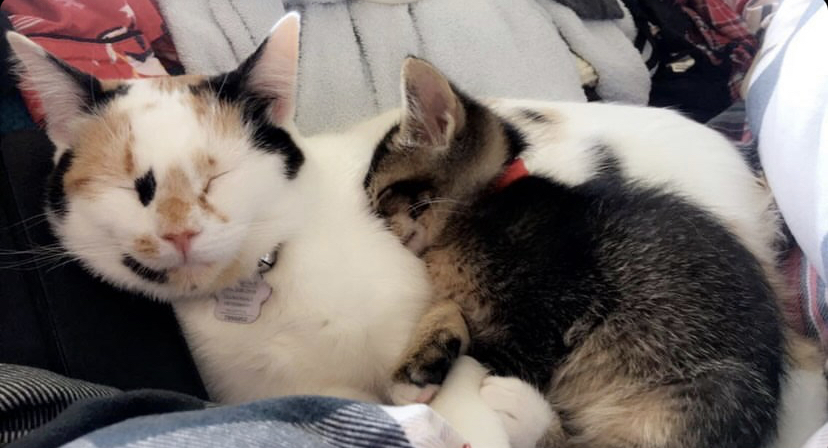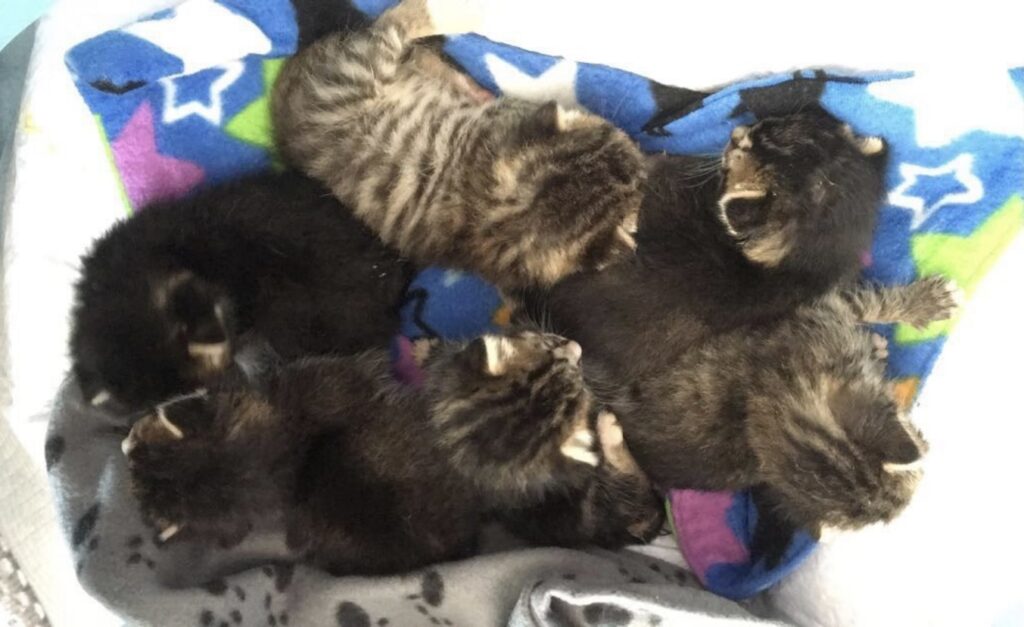By Madison Schuliakewich
Jennifer Grosse fiddles with her laptop as she sits down on her brown couch, often peering over at the small litter of orange kittens snuggled up to their mother in a small corner of her one bedroom condo.
Grosse began fostering cats and kittens three or four years ago, during a time when she was recovering from a work related injury.
“I was kind of like, well, what can I do with my time rather than, you know, arguing with W.S.I.B. (Workplace Safety and Insurance Board) and my employer all day every day?” Grosse says with a chuckle.

She explains how some people are happy just to foster, but many people get sucked in and start to understand the bigger and broader issues there are in animal welfare, especially now with the uncertainty of the effects on animals, both during and after the COVID-19 pandemic comes to an end.
“Everyone’s on every shelter’s adoption list,” says Grosse grimly. “They just want a pet. Many people have gotten to a point where they’re so frantic to get a pet that they’re not really considering if they’re the best fit for that animal.”
Hannah Sotropa, the public relations specialist at The Toronto Humane Society, backs this claim, explaining that the Toronto Humane Society alone has seen over 11,000 applications since closure.
While shelters are definitely exciting to see so many animals go to their forever homes, there is an underlying fear that these homes won’t really be ‘forever.’
Christeena Sayasa, a stay at home mom with three young children, is one of the lucky ones who ended up with a new furry friend just this past March.
“It was so weird,” Christeena laughs. “I’ve read about so many people having such a hard time trying to get a puppy or a dog, and here I am getting multiple calls from different agencies saying ‘hey, we approved your application. Are you still interested?’”

Grosse explains that with this surge in adoption applicants, this means that shelters get the opportunity to be a lot pickier about where their animals go.
Running a Facebook group called, ‘PETS IN RESCUES & NEED REHOMING IN ONTARIO CANADA,’ Grosse sees a lot of complaints about the pickiness in adoption these days.
“You can scroll down on almost every post, and you’ll see complaints of people saying, ‘I’ve applied to rescues, I haven’t heard back, they’re too strict. They won’t give me a dog if I don’t have a fenced-in-yard, if I don’t earn enough money, or if I have small children,’” she says with a sigh.
“People love animals, but what we’ve reached in Toronto is a point in animal welfare where they should ideally be, in some ways, similar to children. Love isn’t enough, it’s about what’s best for the animal.”
A lot of rescues, according to Grosse, have been worried about whether or not there will be a flood of animals into shelters once lockdown ends.
“As far as I’m aware, we haven’t seen that yet,” she explains. “But I mean, the provincial governments’ been flicking that light switch on and off, so life isn’t quite back to normal.”
Sortopa explains that being turned into shelters isn’t the only concern for animals at this point in time.
For those who have gotten animals during lockdown, Sotropa urges them to work on independence training now.
What this means is building an animal’s confidence in being left alone, which is something they may lack if they’re not used to that sort of lifestyle.
“If you do know that you are going to have to resume a semi-regular routine, or a routine that is similar to what you had before once all this comes to an end, starting to mimic what that looks like in the animals routine now will help to make that transition a little bit smoother,” Sotropa says.
Certified applied animal behaviourist, Janet Cutler, has worked as a behaviourist since about 2005. Primarily helping with cat and dog behaviour problems, Cutler often helps pet owners work with animals that have aggression and fear type problems, such as separation anxiety.
She, too, advises to work on these issues sooner rather than later.
“If you have a dog, let’s say, that’s got a behavior problem and you wait a long time to start to deal with it, the dog has practiced that behavior for so long that it takes longer to actually work on the problem. So, if we can catch behavior problems earlier, we have a much higher rate of success for behavior modification and working on those problems,” explains Cutler.
Grosse suggests that anyone looking to adopt right now consider fostering first, to get a sense of all the work that really goes into it.
“I’ll show you some cute fluffy ginger kittens,” she laughs and points her camera down at her own current fosters.
The mother cat, Momma Ruda, as Grosse refers to her, stares up at her as she lifts one of the kittens from her.
“This is little Ron Weasley,” she grins as she grabs the kitten’s paw and waves it at the camera.
“Don’t your ovaries just skip a beat?” Grosse laughs and cradles little Ron into her chest.

“It’s just unfortunate… There’s a short period of time where they’re cute and fluffy, and people want them,” she says.
Adoption can be a couple decades of commitment, depending on the type of animal and breed, and come with a lot more work than you might realize.
Grosse blinks up at the ceiling as she recalls her first foster cat, and “foster-fail” as she called it, since she ended up adopting her.
“I don’t want to start crying,” she whispers quietly as she stares anywhere but the screen, but begins explaining the story anyways.
“At the time I had young kittens that needed to be bottle fed every two hours around the clock. I was so sleep deprived, it almost cost me my marriage,” she laughs slightly.
“Carla, my foster-fail, would take over and watch over them while I slept, and even ended up producing milk to nurse them, which is really rare.”
She wipes away tears and smiles sadly at the camera, explaining that she had felt that if she didn’t take care of them, no one would.
Grosse explains that perhaps bottle-babies are often euthanized as city shelters don’t always have the resources or ability to care for them.
While adoption doesn’t always mean facing difficulties to this extent, there is always the possibility of facing challenges beyond your preparedness.
Grosse urges that if you do have an adoption fail, to always return that animal to the shelter or rescue you adopted them from.
Sayasa dealt with one herself last year, and though it hurt to return her new beloved animal, she knew it wasn’t the right fit and that releasing it into the wild to fend for itself wasn’t an option.
“I think the hardest part was just, you know, feeling the guilt of breaking my kid’s heart,” she explains. “But the process for getting her back was pretty straightforward, and they were really great about not making me feel guilty.”
Sotropa explains that while living in a shelter isn’t ideal for an animal, if you realize that you’re not ready to adopt or that an animal isn’t the right fit for you, there’s no rush!
“We have four dog parks in the back. There’s an obstacle course in one, there’s one that’s a big grassy area. We also have doggy pools, which is nice too,” she says with a big smile. “Sometimes in the summertime they can splash around in the water, so they’re definitely treated well!”
While the uncertainty of both the pandemic and the future of many animals does ignite some worry, Sotropa remains positive of her faith in Torontonians.
“We’ve always had a pretty robust pool of adopters in Toronto. This is a city who just loves animals… The demand may be increased, but I don’t think it’ll ever entirely disappear.”
